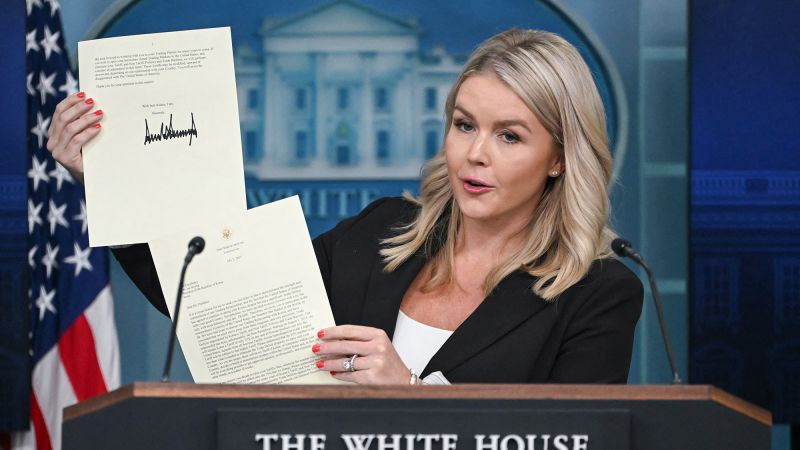CNN
—
President Donald Trump cranked up the pressure Monday on America’s trading partners, firing off letters to heads of several countries, informing them of their new tariff rate. But at the same time, the White House said Trump would take some of the edge off, with plans to sign an executive action Monday to extend the date for all “reciprocal” tariffs to August 1.
Those “reciprocal” tariffs were expected to go into effect Wednesday. In some cases, the letters Trump sent specify new “reciprocal” tariff rates that are higher or lower compared to April levels.
Japan’s Prime Minister Shigeru Ishiba and South Korea’s President Lee Jae-myung were the first recipients of Trump’s letters.
Both countries will face a 25% tariff come August 1, Trump said in posts on Truth Social displaying the letters, potentially giving countries more time to negotiate deals. Around two hours later, he announced similar letters were sent to Malaysia, Kazakhstan, South Africa, Myanmar and Laos, informing their leaders of new tariff rates as high as 40%.
Even more letters could be coming: Trump is set to announce “approximately 12 of these letters” on Monday, White House press secretary Karoline Leavitt told reporters at a news briefing. The letters will be announced via social media posts from the president, she said, but declined to preview which countries would be named.
In the two nearly identical letters sent to Japan and South Korea, Trump said he takes particular issue with the trade deficits the United States runs with them, meaning America buys more goods from there compared to the amount that American businesses export to those countries. Trump also said the tariffs would be set in response to other policies that he deems are impeding American goods from being sold abroad. Trump made similar comments in the other five letters he sent on Monday.
“Please understand that the 25% number is far less than what is needed to eliminate the Trade Deficit disparity we have with your Country,” Trump says in both letters.
He encouraged both countries to manufacture goods in the United States to avoid tariffs.
This comes ahead of his initial 12:01 a.m. ET July 9 deadline for countries to make deals or face the threat of higher tariffs. That date marks the end of the pause on “reciprocal” tariffs, which briefly went into place in April. Since then, impacted countries have faced a minimum 10% tariff.
However, Leavitt said Trump will sign an executive order on Monday pushing that deadline to August, which is “in the best interest of the American people.” She also said Trump’s phone “rings off the hook from world leaders all the time who are begging him to come to a deal.” Yet only three deals have been announced over the past three months.
Two key trading partners and allies on notice
“There will be no tariff” if South Korea or Japan or “companies within your Country, decide to build or manufacture product within the United States and, in fact, we will do everything possible to get approvals quickly, professionally, and routinely-In other words, in a matter of weeks,” Trump said in his letters.
He also threatened to raise tariffs higher than 25% if South Korea or Japan retaliated against the United States with tariffs of their own.
Japan and South Korea are America’s sixth- and seventh-largest trading partners, respectively. Last year, both shipped a combined $280 billion worth of goods to the United States last year, according to US Commerce Department figures. Meanwhile, they bought a combined $145 billion worth of goods from the US.
The prospect of higher tariffs on both nations’ goods could translate into higher prices for American consumers. Among the top goods America imports from those countries are cars, auto parts, semiconductors, pharmaceuticals and machinery. Trump has placed or threatened to levy industry-specific tariffs on many of these goods.
“If for any reason you decide to raise your Tariffs, then, whatever the number you choose to raise them by, will be added onto the 25% that we charge,” Trump also said.
In April, Japan was set to face a 24% tariff, while South Korea was set to face a 25% tariff. Trump said these rates would be “separate from all Sectoral Tariffs,” meaning, for instance, the new tariff won’t be stacked on top of the current auto tariff of 25%, the White House confirmed. That would apply to any future sector-specific tariffs, too, a White House official said.
Despite this, auto stocks of companies that have a heavy manufacturing presence in Japan and South Korea declined sharply. For instance, US-listed shares of Nissan Motors were down over 7%, while Toyota and Honda shares were down 4%.
Those declines, however, may reflect the increased likelihood of Trump potentially raising tariffs on cars from the two countries should they retaliate against the general 25% tariffs, were they to go into effect, by slapping higher tariffs on American goods.
“These Tariffs may be modified, upward or downward, depending on our relationship with on our relationship with your Country. You will never be disappointed with The United States of America,” Trump ended the letters before signing off.
US stocks, which were already sliding, dropped lower after more tariffs were announced. The Dow moved lower by 667 points, or 1.48%. The S&P 500 fell 1.19% and the Nasdaq fell 1.27%.
This is a developing story and will be updated.

